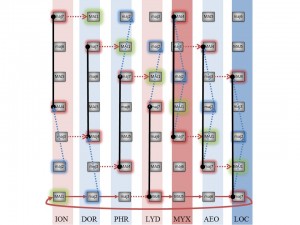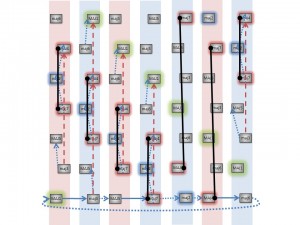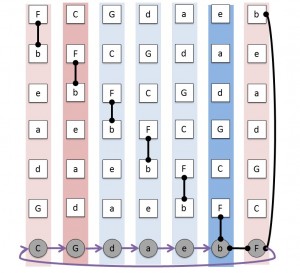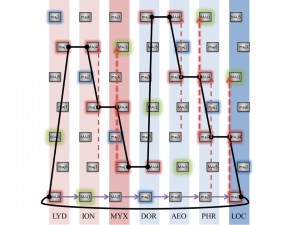Plainspeak:
The Tritone’s role throughout history has been misunderstood and while it is not a thing to be avoided, it is certainly best to minimize it. KCM views the tritone as a guide, as the opposite of the key you are in, and as a reminder of the chromatic scale from whence all scales are born. Further, the diagrams clearly indicate that our ears prefer to stay on weak Tritones, those furthest from the bass note, while they want to move away from strong Tritones, those closest or on the bass note. This observation will allow us to Harmonically categorize all chords/modes as either Tonic, Dominant, or Subdominant, a designation that will have meaning across all scale.
Visuals that support this axiom:
Key-Chord major tritones
Axiom 2 Corollary 1 (A2C1): Tritones within any two 13th chords determine dynamics between the corresponding two modes
Getting to know the Tonic expectation.
Tonic movement, tonic quality, 1 to 1 or `1 to 8 Unison
“Wants you to stay home or go home”
Two tonics, Minor (Aeolian) and Major (Ionian).
?One conditional Tonic, Phrygian (if Aeolian missing).
Weak Tritone
Getting to know the Dominant expectation.
Dominant movement, dominant quality, 5 to 1, “retrogression”
“Wants to move you in fifths to get home”
Two dominants, Minor (Diminished) and Major (Dominant)
?One conditional Dominant, Phrygian (if Locrian missing).
Strong Tritone
Getting to know the Subdominant expectation.
Subdominant movement, subdominant quality, 4 to 1, “progression”
“Wants to move you in fourths to get home”
Two Subdominants, minor (Dorian) and major (Lydian)
Ambigous Tritone
- A2C2: Major scale “tritone chain” present in all heptatonic scales
- A2C2.2: Major scale tritone chain is what it means to be “IN
- KEY”A2C3: Different scales add different “tritone chains” on top of the major one.
Disambiguate dominant movement with dominant quality.
Discuss tritone in analysis
- Key Chord Diagram
- Laying out chords; mapping out harmony and melody
Discuss tritone in composition





